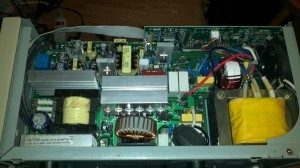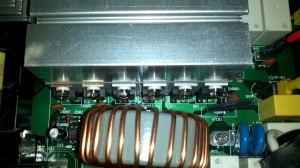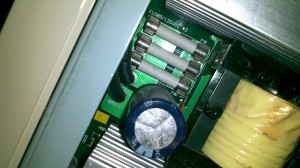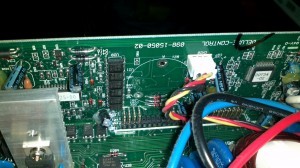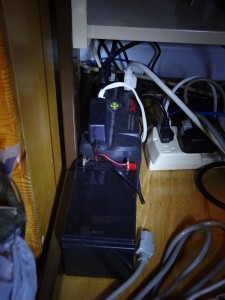ups
PW5115 UPS – Quick Post
Okay, maybe not so quick. Tonight I was playing around inside the Power Ware PW5115 UPS I wrote about here. Over the last several weeks it has been in service, I’ve run into a few problems with it, and cracked it open in hopes of finding some answers (as well as to change the noisy fan for something quieter.)
I was experiencing two issues:
- Every couple of days, the fan will randomly turn off. This happened ever since I got it, and sometimes happened every 4 days, once a week, then it happened twice in two days.
- It was no longer capable of supporting the server when mains was removed.
When I opened it, there was nothing out of the ordinary. No bulging caps of anything of the sort. I believe at this point I can attribute the problem to aging, ready to retire batteries.
This is the huge bus capacitor at the 36VDC input. It has enough power that, when the batteries are disconnected, it can fire several relays and hold them for a second, before finally dying. As well, when the battery pack is connected initially, considerable current is sucked to charge this cap, enough that a large blue arc appears, creating ozone and smoke. Awesome.
Here you can see where the buzzer used to be, removed to preserve my sanity. I don’t know if any of you have a UPS (or two) in your bedroom, but they will beep, non stop, for no reason. Power failed? Beep every 2 seconds. Battery dying? Beep continuously. If a power outage happens at 3am, this is not a sound you want to be woken up for. It has happened to me, and the adrenaline rush is actually kind of unpleasant.
To the top right of the buzzer footprint you can see a black-red-yellow wire. This is the wire going to the fan. I plan on replacing the stock turbine with a much quieter CPU fan. The turbine didn’t really even move that much air, anyway.
Uninterruptible Power Supply
Being a very technology-inclined person, electricity has an important role in much of my daily life. Many of my tools require it (I include computers in this category) and, when the power goes out, it is the absence of server noise that alerts me, not that of light. The best way to keep these devices running is with a UPS (see previous post on the subject).
Network
Above is the “defender of the Internet” – this UPS keeps the modem, router, gigabit switch (and in passing, my amplifier) powered in the event of a power outage.
This UPS was $15 at a thrift store, is rated for 350VA (so… 275W?), and originally came with a 7Ah battery. Naturally, the battery was toast. I instead ran some wire from the terminals to a 12Ah battery from a broken car booster pack. Yes, I simply wrapped the wire around the terminal.
I haven’t tested the life span, however I once left it unplugged, with my amplifier playing music, for 30 minutes without failure. Boredom led me to plug it back in. I expect it should last several hours powering only the network.
Server
The server has 8 hard drives, and consumes a fair amount of electricity (more than the small UPS can provide). Because of this, a much larger UPS is needed. While browsing Kijiji one day, it occurred to me that I’ve never checked there for a UPS before. It was a good thing I did this time:
DIY: UPS
March break has found me a project! Here is a little background. My friend’s dad gave me an old Uninterruptable Power Supply (UPS) he had at home, but that the battery was no good. I have plenty of batteries, so this was a non-issue. The UPS was a godsend because that same day I had gone shopping for one, but not found one suitable for the server.

When I took this used UPS home, and hooked up all the batteries in my arsenal, I discovered that it was too weak to power the server for more than 2 seconds. Bummer. Even for power flickers that was not suitable, as there is a 5 second delay after the power returns before it switches back to mains power. What to do, what to do…
Oh, I know. Make my own!
Update: My testing proceedures blocked me from finding one critical fault with the design. As you will notice, I am using a resistor in order to short the capacitor from the AC-DC adapter, in order to more quickly de-energize the relays. Unfortunately, it still isn’t fast enough. My testing involved simply unplugging the adapter, and checking for any flickering in the devices. However, this testing does not remove mains power. Thus, the slight lag time for switch over does not affect the device, as it is has power on both relay positions. However, in a real situation, the power fails, both on input power and the adapter, and I’ve tested that my switch over time in this case is too great for most devices.
Fix to come…
